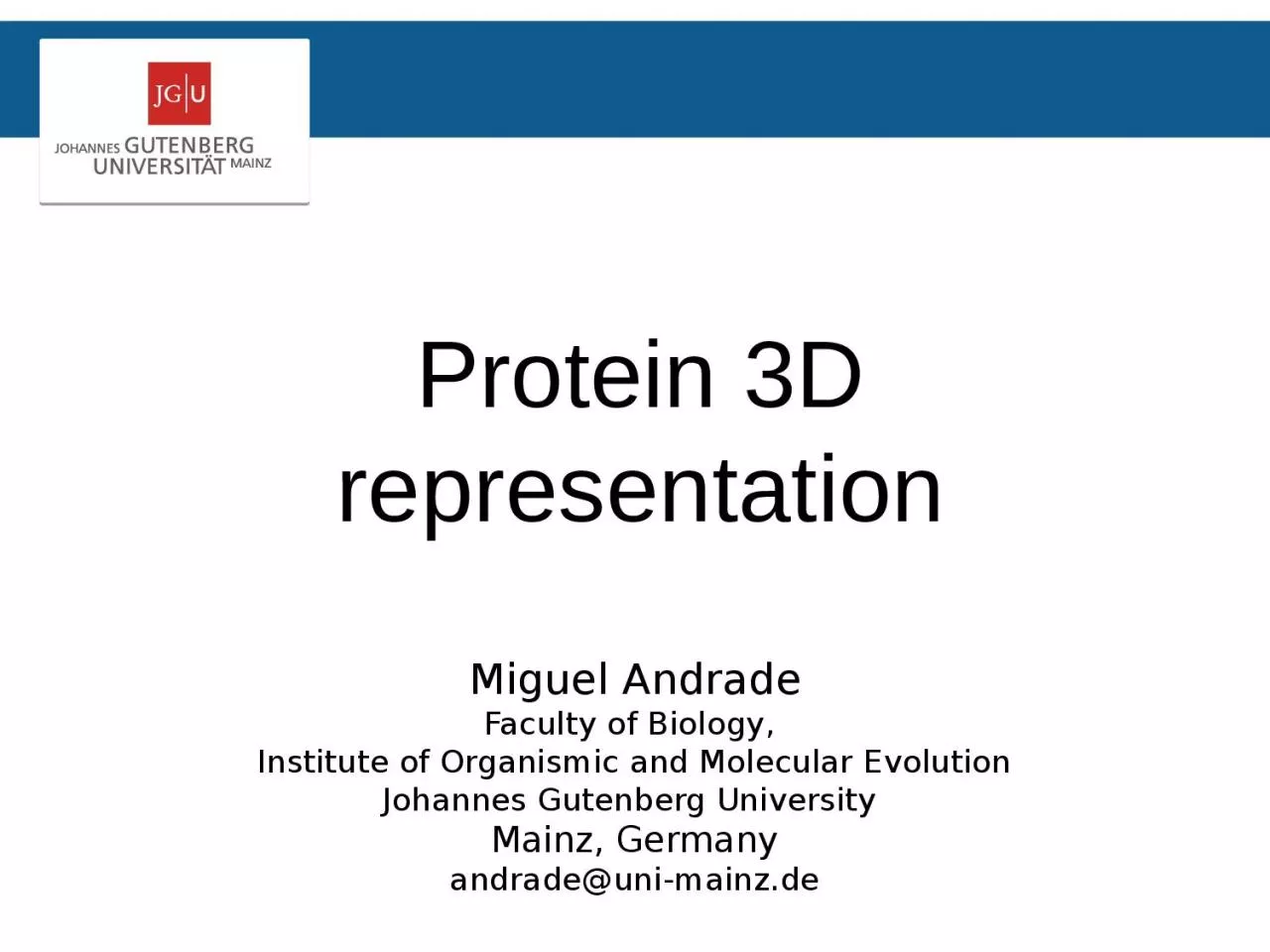

Miguel Andrade Faculty of Biology Institute of Organismic and Molecular Evolution Johannes Gutenberg University Mainz Germany a ndradeunimainzde Chimera Chimera 13 Starting Chimera ID: 1043063
Download Presentation The PPT/PDF document "Protein 3D representation" is the property of its rightful owner. Permission is granted to download and print the materials on this web site for personal, non-commercial use only, and to display it on your personal computer provided you do not modify the materials and that you retain all copyright notices contained in the materials. By downloading content from our website, you accept the terms of this agreement.
1. Protein 3D representation Miguel AndradeFaculty of Biology, Institute of Organismic and Molecular EvolutionJohannes Gutenberg University Mainz, Germanyandrade@uni-mainz.de
2. Chimera
3. Chimera 1/3Starting ChimeraOpen Chimera from desktop (ZDV app) (If there is an update it will take a minute or two)Open a 3D structure by PDB id:Try 3PZDThis is human myosin X (chain A) in complex with a peptide (chain B)Go to File > Fetch by ID > PDBType 3pzd in the window
4. Removing a structureAt the main menu go toFile > Close sessionThen you can start again with the next structure(otherwise structures are added)
5. Open again 3PZDViewing a structureClick mouse left button and slide to rotate.Click right button and slide to zoom in and outPause pointer on a residue to see number and chainThis indicates amino acid, number and chain. (e.g. GLN1511.A)Find residue 1723 in chain A. Which type of amino acid is it? What is the secondary structure conformation of this residue?Find chain B. What is the most abundant secondary structure for this chain?
6. Open again 3PZDViewing a structureThese are fragments: the numbers correspond to the positions in the complete proteins.Note the gaps, e.g. between positions 1963-1969 of chain A. What do these gaps mean?Note that there is a molecule represented, which is not a protein. That molecule is glycerol.
7. SelectingCtrl and click to select a single residueMenu Select > Chain > to select a whole chainSelect > zone > (try a distance range < 5A)If a residue or atom is selected: arrow up selects its chain, up twice selects all chains. Arrow down goes back.Left/right arrows inverts selection.
8. Selecting by residue numberSelect > Atom specifier > This opens a little window where you can type ranges.Examples::1510-1520.a(Hint: Type Apply and not OK to keep the window open)Selects residues 1510 to 1520 in chain A:1425-1434.bSelects residues 1425 to 1434 in chain B
9. FocusingSelect a residue (ctrl + click)Actions > FocusThis will close the view on the selectionGet back to the original view by selecting the whole molecule (arrow up) and doing again:Actions > FocusTry this again with a selection of a protein fragment. The view will focus on the selected fragment.Set pivotSelect a residueActions > Set pivotThis will make the rotation center on the selection
10. Try these steps on the molecule of glycerolYou can see which residues are close to the molecule of glycerol:Select > zone > Then specify in the window that appears: select all atoms at <5.0 angstroms from the selectionHow many residues are at less than 5.0 angstroms from the glycerol molecule?Is there a cysteine among those? Which residue number?To get back select all (arrow up) then Actions > Focus
11. Measuring distancesKeep the focus on the molecule of glycerol. We can measure how far from it are the atoms of the side chains of the residues around it.Tools > Structure analysis > distancesTo define a distance select one atom in the glycerol with Ctrl+click and a second in a side chain of an amino acid in the protein with Shift+Ctrl+click. Then press the button “Create” in the small window.What is the closest distance of an oxygen of the glycerol to the sulfur of cysteine 1706?To get back select all (arrow up) then Actions > Focus
12. Colouring a peptide chainSelect chain BSelect > chain > BActions > color > redChanging representationDefault is ribbonTry other things:Actions > Atom/Bonds > ShowActions > Atom/Bonds > sticksYou can hide the ribbon of the (selected) chain B.Actions > Ribbon > hideRepresent the glycerol as atom spheres.How can you use representation to check if the glycerol is exposed to the solvent or not? What is the result?
13. Chimera 2/3Close session and load 3PQRThis is rhodopsin, a transmembrane proteinLet’s find the hydrophobic part of the proteinColor residues by propertyFirst select: Select > Residue > amino acid category > hydrophobicThen color:Actions > colour > blueGenerate a surfaceSelect > chain > AActions > surface > show
14. Chimera 3/3Close session and load 1GLUThis is the glucocorticoid receptor dimer bound to DNA Let’s found out if the interface of interaction with DNA has positively charged amino acidsColor residues by propertyFirst select: Select > Residue > Amino acid category > positiveThen color: Actions > Color > blue(Also color negative residues red)
15. Chimera 3/3Generate a surface(Script is a bit buggy when things are on the way – we remove the DNA first)Select the DNA chains and then delete them:Actions > Atoms/Bonds > Delete(This cannot be undone!)Now we do the surface:Actions > Surface > ShowHow to get back the DNA? Fetch again 1GLU without closing the session (the new molecule will be overlapped)